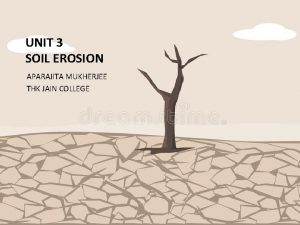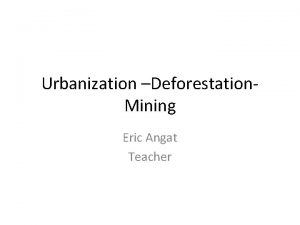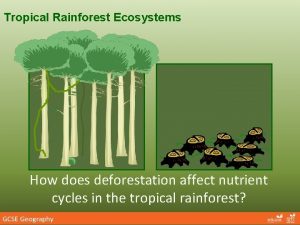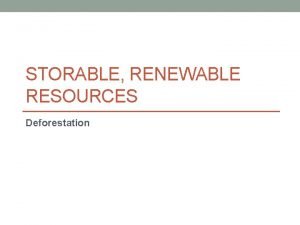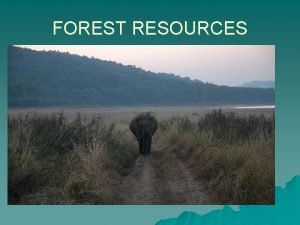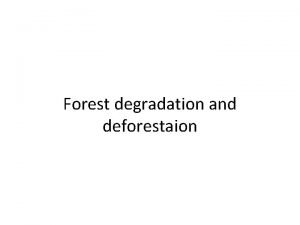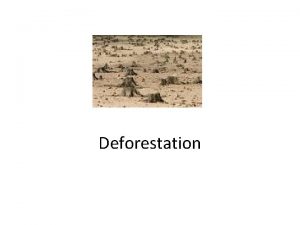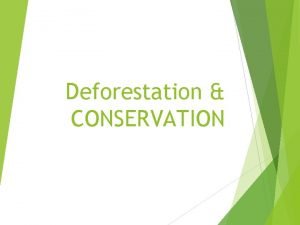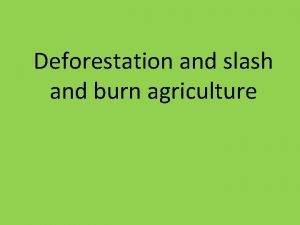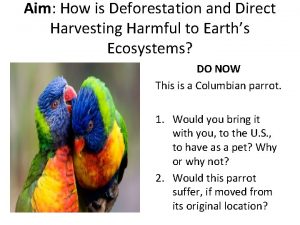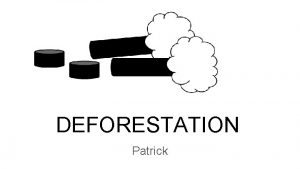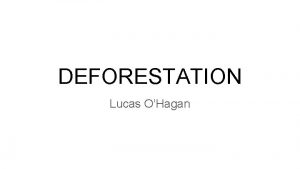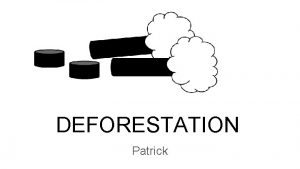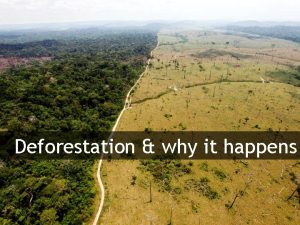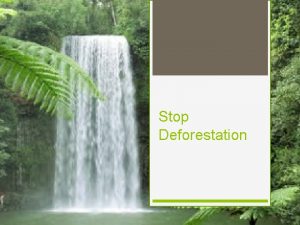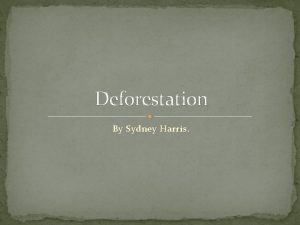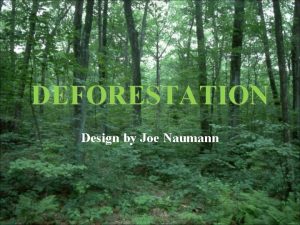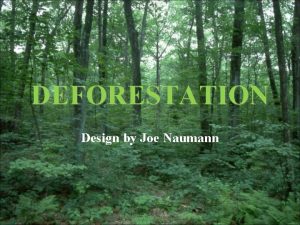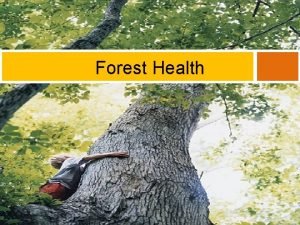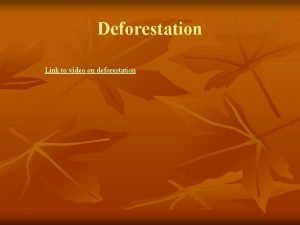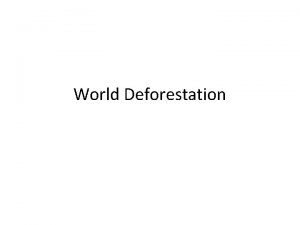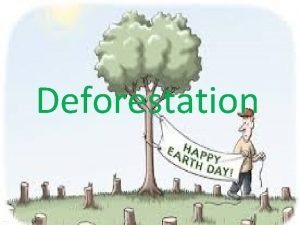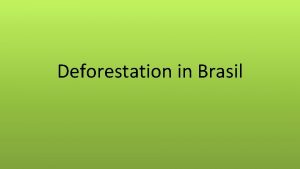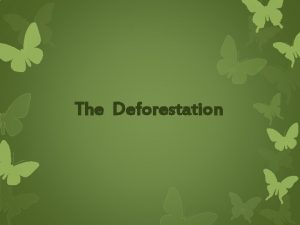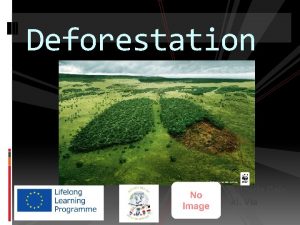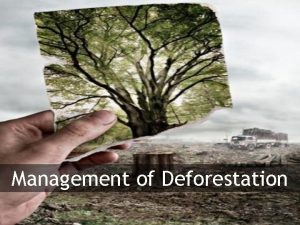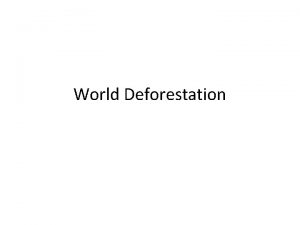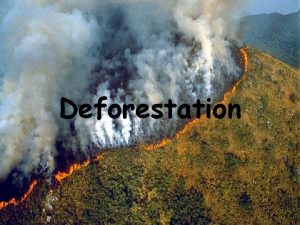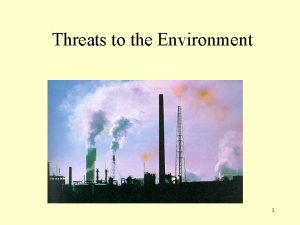DEFORESTATION APARAJITA MUKHERJEE THK JAIN COLLEGE UNIT 3

























- Slides: 25

DEFORESTATION APARAJITA MUKHERJEE THK JAIN COLLEGE UNIT 3

WHAT IS DEFORESTATION? • Deforestation, clearance, clearcutting or clearing is the removal of a forest or stand of trees from land which is then converted to a non-forest use • Deforestation can involve conversion of forest land to farms, ranches or urban use. • The most concentrated deforestation occurs in tropical rainforest • About 31% of Earth's land surface is covered by forests.

CAUSES OF DEFORESTATION q Agriculture: According to the United Nations Framework Convention on Climate Change (UNFCCC) secretariat, the overwhelming direct cause of deforestation is agriculture. Ø Subsistence farming is responsible for 48% of deforestation; Ø Commercial agriculture is responsible for 32%; Ø logging is responsible for 14%, Ø and fuel wood removals make up 5%. q Ranches: Forests are transformed into livestock farmlands are cattle grazing area. q Industries: Forest area being converted to industrial sites, factory build up and business sector points. By the 1990 s the majority of deforestation was caused by industrial factors, including extractive industries, large-scale cattle ranching, and extensive agriculture. q Livelihood under poverty: Poor people are more likely to clear forest because they have no alternatives, others that the poor lack the ability to pay for the materials and labour needed to clear forest. One study found that population increases due to high fertility rates were a primary driver of tropical deforestation in only 8% of cases

CAUSES OF DEFORESTATION q Climate change: 23% of tree cover losses result from wildfires and climate change increase their frequency and power. The rising temperatures cause massive wildfires especially in the Boreal or taiga forests q Population: The role of population dynamics in a local forest is important. Deforestation can result from "a combination of population pressure and stagnating economic, social and technological conditions”. q Economic incentives provided by the forest: Forest produces make forest conversion appear more profitable than forest conservation From the perspective of the developing world, the benefits of forest as carbon sinks or biodiversity reserves go primarily to richer developed nations and there is insufficient compensation for these services. Since 2001, , which is more likely to be permanent, Commodity-driven deforestation has accounted for about a quarter of all forest disturbance, and this loss has been concentrated in South America and Southeast Asia. q Government-sponsored development projects: Deforestation was primarily driven by such processes like transmigration in countries like Indonesia and colonization in Latin America, India and Java, and so on, during the late 19 th century and the earlier half of the 20 th century caused q Other causes of contemporary deforestation: This may include: Ø Corruption of government institutions, illegal permission Ø Inequitable distribution of wealth and power Ø Urbanization and Globalization are often viewed as root cause of deforestation. Though new flows of labor, capital, commodities, and ideas have promoted localized forest recovery.

CONSEQUENCES… 1. Environment 2. Health 3. Economy

1. ENVIRONMENTAL EFFECTS

1. ENVIRONMENTAL EFFECTS INCLUDE: v Atmospheric effects: • Deforestation is a contributor to global warming and is often cited as one of the major causes of the enhanced greenhouse effect. • Tropical deforestation is responsible for approximately 20% of world greenhouse gas emissions • Tropical deforestation alone can account for up to one-third of total anthropogenic Carbon dioxide emission. • Plants remove carbon in the form of carbon di-oxide from the atmosphere during the process of photosynthesis but release some carbon dioxide back into the atmosphere during normal respiration. Only when actively growing can a tree or forest remove carbon, by storing it in plant tissues. Both the decay and the burning of wood release much of this stored carbon back into the atmosphere. • In deforested areas, the land heats up faster and reaches a higher temperature

v Hydrological effects: • The water cycle is also affected by deforestation. Trees extract groundwater through their roots and release it into the atmosphere. When part of a forest is removed, the trees no longer transpire this water, resulting in a much drier climate. Hence, reduces the content of water in the soil and groundwater as well as atmospheric moisture. • Deforestation reduces soil cohesion, so that erosion, flooding and landslides are more likely to occur. • Shrinking forest cover lessens the landscape's capacity to intercept, retain and transpire precipitation. Instead of trapping precipitation, which then percolates to groundwater systems, deforested areas become sources of surface water runoff, which moves much faster than subsurface flows.

v Hydrological effects: • Forests return most of the water that falls as precipitation to the atmosphere by transpiration. In contrast, when an area is deforested, almost all precipitation is lost as run-off. • That quicker transport of surface water can translate into flash flooding and more localized floods than would occur with the forest cover. Deforestation also contributes to decreased evapotranspiration which lessens atmospheric moisture which in some cases affects precipitation levels downwind from the deforested area, as water is not recycled to downwind forests, but is lost in runoff and returns directly to the oceans. According to one study, in deforested north and northwest China, the average annual precipitation decreased by one third between the 1950 s and the 1980 s. • Tropical rainforests produce about 30% of our planet's fresh water • Deforestation disrupts normal weather patterns creating hotter and drier weather thus increasing drought, desertification, crop failures, melting of the polar ice caps, coastal flooding and displacement of major vegetation regimes

v. Pedological effects: • Forests that are undisturbed have a minimal rate of erosion because the trees protect soil from surface runoff. • Forest secure the soil by binding their roots to soil bedrock. Due to deforestation, the removal of trees causes nudation of the soil which leads to soil erosion by several natural and anthropogenic forces. • Deforested sloped lands are also very much susceptible to landslides

v. Effects on Biodiversity • Forests support biodiversity, providing habitat for innumerable numbers of plant and wildlife. The removal or destruction of areas of forest cover has resulted in a degraded environment with reduced biodiversity. • Forests foster medicinal conservation which is also lost with forest destruction. • Deforestation can destroy genetic variations irretrievably. • Since the tropical rainforests are the most diverse ecosystem on Earth and about 80% of the world's known biodiversity could be found in tropical rainforests, removal or destruction of significant areas of forest cover has resulted in a degraded environment with reduced biodiversity.

Such a threat!! • It has been estimated that we are losing 137 plant, animal and insect species every single day due to rainforest deforestation, which equates to 50, 000 species a year.

2. HEALTH EFFECTS • According to the World Economic Forum, 31% of the emerging diseases are linked to deforestation. Kate Jones, chairperson of ecology and biodiversity at University College, London, says the disruption of forests driven by logging, mining, road building through remote places, rapid urbanization and population growth is bringing people into closer contact with animal species they may never have been near before, resulting in transmission of zoonotic diseases from wildlife to humans. • Experts say that anthropogenic deforestation, habitat loss and destruction of biodiversity may be linked to outbreaks like the 2019 -20 Corona virus pandemic in several ways. According to American science journalist David Quammen, "We cut the trees; we kill the animals or cage them and send them to markets. We disrupt ecosystems, and we shake viruses loose from their natural hosts. When that happens, they need a new host. Often, we are it”.

3. ECONOMIC IMPACT • Utilization of forest products, including timber and fuel wood, has played a key role in human societies, comparable to the roles of water and cultivable land. Today, developed countries continue to utilize timber for building houses, and wood pulp for paper. In developing countries, almost three billion people rely on wood for heating and cooking. • Damage to forests and other aspects of nature could halve living standards for the world's poor people who solely depend upon forests and reduce global GDP by about 7% by 2050 • The forest products industry is a large part of the economy in both developed and developing countries. Short-term economic gains made by conversion of forest to agriculture, or over exploitation of wood products, typically leads to a loss of long-term income and long-term biological productivity. • Rapidly growing economies also have an effect on deforestation. Most pressure will come from the world's developing countries, which have the fastest-growing populations and most rapid economic (industrial) growth. • As our human population grows, new homes, communities, and expansions of cities will occur. Connecting all of the new expansions will be roads, a very important part in our daily life. Rural roads promote economic development but also facilitate deforestation. About 90% of the deforestation has occurred within 100 km of roads in most parts of the Amazon.

REMEDIAL MEASURES

1. Reducing emissions • Main international organizations including the United Nations and the World Bank, have begun to develop programs aimed at curbing deforestation. The blanket term Reducing Emissions from Deforestation and Forest Degradation (REDD) describes these sorts of programs, which use direct monetary or other incentives to encourage developing countries to limit and/or roll back deforestation • In evaluating implications of overall emissions reductions, countries of greatest concern are those categorized as High Forest Cover with High Rates of Deforestation (HFHD) and Low Forest Cover with High Rates of Deforestation (LFHD).

2. Payments for conserving forests • Lucrative initiatives are often being taken by Government to conserve forest. For example: In Bolivia, deforestation in upper river basins has caused environmental problems, including soil erosion and declining water quality. An innovative project to try and remedy this situation involves landholders in upstream areas being paid by downstream water users to conserve forests. The landholders receive US$20 to conserve the trees, avoid polluting livestock practices, and enhance the biodiversity and forest carbon on their land. They also receive US$30, which purchases a beehive, to compensate for conservation for two hectares of water-sustaining forest for five years.

3. Farming • New methods are being developed to farm more intensively, such as high-yield crops, crop rotations. These methods are often dependent on chemical inputs to maintain necessary yields. • In cyclic agriculture, cattle are grazed on farm land that is resting and rejuvenating. Cyclic agriculture actually increases the fertility of the soil. • Intensive farming can also decrease soil nutrients by consuming at an accelerated rate the trace minerals needed for crop growth. • The most promising approach, however, is the concept of permaculture, which consists of agroforestal systems carefully designed to mimic natural forests, with an emphasis on plant and animal species of interest for food, timber and other uses. These systems have low dependence on fossil fuel and agro-chemicals, are highly self-maintaining, highly productive, and with strong positive impact on soil and water quality, and biodiversity

4. Forest management • Efforts to stop or slow deforestation have been attempted for many centuries because it has long been known that deforestation cause environmental damage sufficient in some cases to cause societies to collapse. There should be a highly sophisticated system of long-term planning to stop and even reverse deforestation of the preceding centuries through substituting timber by other products and more efficient use of land that had been farmed. • In the areas where “slash-and-burn" is practiced, switching to “slash -and-char" would prevent the rapid deforestation and subsequent degradation of soils. Charring is a chemical process of incomplete combustion of certain solids when subjected to high heat. Heat distillation removes water vapor and organic volatile compounds from the matrix. The residual black carbon material is char which is composed primarily of carbon. The biochar thus created, given back to the soil, is not only a durable carbon sequestration method, but it also is an extremely beneficial amendment to the soil.

A concept of developing relationships between fringe forest groups and forest department on the basis of mutual trust and jointly defined roles and responsibilities forest protection and development is referred to as……. .

5. Sustainable practices • According to the United Nations Food and Agriculture Organization (FAO), "A major condition for the adoption of sustainable forest management is a demand for products that are produced sustainably and consumer willingness to pay for the higher costs entailed”. • Some nations have taken steps to help increase the number of trees on Earth. In 1981, China created National Tree Planting Day Forest and forest coverage had now reached 16. 55% of China's land mass, as against only 12% two decades ago. • Using fuel from bamboo rather than wood results in cleaner burning, and since bamboo matures much faster than wood, deforestation is reduced as supply can be replenished faster.

6. Reforestation • In many parts of the world, especially in East Asian countries, reforestation is increasing the area of forested lands. • Afforestation is the establishment of a forest or stand of trees in an area where there was no previous tree cover. This process is also helping. The amount of woodland has increased in 22 of the world's 50 most forested nations. • Based on these trends, one study projects that global forestation will increase by 10%—an area the size of India —by 2050. [

Hence to spread awareness about the environment and the importance of forests International Day of Forests or the World Forest Day is celebrated on March 21 annually over the world.

SAVE FORESTS

THANK YOU
 Aparajita jain
Aparajita jain Sumana sen
Sumana sen Dip mukherjee surgeon
Dip mukherjee surgeon Shrijeet mukherjee
Shrijeet mukherjee Pablo mukherjee
Pablo mukherjee Shourya mukherjee
Shourya mukherjee Larson miller
Larson miller Shubu mukherjee
Shubu mukherjee Vikram mukherjee
Vikram mukherjee Mukherjee committee 1965
Mukherjee committee 1965 Recommendation of jungalwalla committee
Recommendation of jungalwalla committee Asb45r
Asb45r Türk hava kurumu üniversitesi bilgisayar mühendisliği
Türk hava kurumu üniversitesi bilgisayar mühendisliği Thkü erasmus
Thkü erasmus Thk 3
Thk 3 Tarzan deforestation
Tarzan deforestation Define atmosphere
Define atmosphere How does deforestation affect the nutrient cycle
How does deforestation affect the nutrient cycle Objectives for deforestation
Objectives for deforestation Case study on deforestation in andaman and nicobar islands
Case study on deforestation in andaman and nicobar islands Deforestaion
Deforestaion What is deforestation
What is deforestation Déforestation
Déforestation Definition of slash and burn
Definition of slash and burn Which phrase best describes the biosphere?
Which phrase best describes the biosphere? Direct harvesting meaning
Direct harvesting meaning
